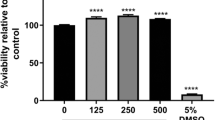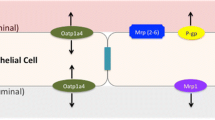Abstract
Purpose
Biometals such as zinc and copper have been shown to affect tight junction expression and subsequently blood-brain barrier (BBB) integrity. Whether these biometals also influence the expression and function of BBB transporters such as P-glycoprotein (P-gp) however is currently unknown.
Methods
Using the immortalised human cerebral microvascular endothelial (hCMEC/D3) cell line, an in-cell western assay (alongside western blotting) assessed relative P-gp expression after treatment with the metal ionophore clioquinol and biometals zinc and copper. The fluorescent P-gp substrate rhodamine-123 was employed to observe functional modulation, and inductively coupled plasma mass spectrometry (ICP-MS) provided information on biometal trafficking.
Results
A 24-h treatment with clioquinol, zinc and copper (0.5, 0.5 and 0.1 μM) induced a significant upregulation of P-gp (1.7-fold) assessed by in-cell western and this was confirmed with western blotting (1.8-fold increase). This same treatment resulted in a 23% decrease in rhodamine-123 accumulation over a 1 h incubation. ICP-MS demonstrated that while t8his combination treatment had no effect on intracellular zinc concentrations, the treatment significantly enhanced bioavailable copper (4.6-fold).
Conclusions
Enhanced delivery of copper to human brain microvascular endothelial cells is associated with enhanced expression and function of the important efflux pump P-gp, which may provide therapeutic opportunities for P-gp modulation.





Similar content being viewed by others
Abbreviations
- Aβ:
-
Amyloid beta peptide
- AD:
-
Alzheimer’s disease
- APS:
-
Ammonium persulfate
- BBB:
-
Blood-brain barrier
- BMEC:
-
Brain microvascular endothelial cells
- CNS:
-
Central nervous system
- CQ:
-
Clioquinol
- DAPI:
-
4′,6-diamidino-2-phenylindole
- EBM2:
-
Endothelial basal medium 2
- EDTA:
-
Ethylenediaminetetraacetic acid
- HBSS:
-
Hank’s balanced salt solution
- hCMEC/D3:
-
Immortalised human cerebral microvascular endothelial cell line
- ICP-MS:
-
Inductively coupled plasma mass spectrometry
- ICW:
-
In-cell western
- IR:
-
Infra-red
- MTT:
-
3-(4,5-dimethylthiazol-2-yl)-2,5-diphenyltetrazolium bromide
- P-gp:
-
P-glycoprotein
- PBS:
-
Phosphate buffered saline
- PSC833:
-
Valspodar
- R123:
-
Rhodamine-123
- SDS:
-
Sodium dodecyl sulfate
- TEMED:
-
Tetramethylethylenediamine
- TRIS:
-
Tris(hydroxymethyl)aminomethane
- WB:
-
Western blot
References
Hawkins BT, Davis TP. The blood-brain barrier/neurovascular unit in health and disease. Pharmacol Rev. 2005;57(2):173–85.
Zlokovic BV. Neurovascular pathways to neurodegeneration in Alzheimer's disease and other disorders. Nat Rev Neurosci. 2011;12(12):723–38.
Tatsuta T, Naito M, Oh-hara T, Sugawara I, Tsuruo T. Functional involvement of P-glycoprotein in blood-brain barrier. J Biol Chem. 1992;267(28):20383–91.
Callaghan R. Providing a molecular mechanism for P-glycoprotein; why would I bother? Biochem Soc Trans. 2015;43(5):995–1002.
Punitha AD, Srivastava AK. CNS drug targeting: have we travelled in right path? J Drug Target. 2013;21(9):787–800.
Fletcher JI, Williams RT, Henderson MJ, Norris MD, Haber M. ABC transporters as mediators of drug resistance and contributors to cancer cell biology. Drug Resist Updat. 2016;26:1–9.
McInerney MP, Short JL, Nicolazzo JA. Neurovascular alterations in Alzheimer's disease: transporter expression profiles and CNS drug access. AAPS J. 2017;19(4):940–56.
Selkoe DJ. Alzheimer's Disease. Cold Spring Harb Perspect Biol. 2011;3(7):a004457–7.
Roberts KF, Elbert DL, Kasten TP, Patterson BW, Sigurdson WC, Connors RE, et al. Amyloid-beta efflux from the central nervous system into the plasma. Ann Neurol. 2014;76(6):837–44.
Shibata M, Yamada S, Kumar SR, Calero M, Bading J, Frangione B, et al. Clearance of Alzheimer's amyloid-ss(1-40) peptide from brain by LDL receptor-related protein-1 at the blood-brain barrier. J Clin Invest. 2000;106(12):1489–99.
Qosa H, Abuasal BS, Romero IA, Weksler B, Couraud PO, Keller JN, et al. Differences in amyloid-beta clearance across mouse and human blood-brain barrier models: Kinetic analysis and mechanistic modeling. Neuropharmacology. 2014;79C:668–78.
Cirrito JR, Deane R, Fagan AM, Spinner ML, Parsadanian M, Finn MB, et al. P-glycoprotein deficiency at the blood-brain barrier increases amyloid-beta deposition in an Alzheimer disease mouse model. J Clin Invest. 2005;115(11):3285–90.
Wang W, Bodles-Brakhop AM, Barger SW. A role for P-glycoprotein in clearance of Alzheimer amyloid beta-peptide from the brain. Curr Alzheimer Res. 2016;13(6):615–20.
Vogelgesang S, Cascorbi I, Schroeder E, Pahnke J, Kroemer HK, Siegmund W, et al. Deposition of Alzheimer's beta-amyloid is inversely correlated with P-glycoprotein expression in the brains of elderly non-demented humans. Pharmacogenetics. 2002;12(7):535–41.
Deo AK, Borson S, Link JM, Domino K, Eary JF, Ke B, et al. Activity of P-glycoprotein, a beta-Amyloid transporter at the blood-brain barrier, is compromised in patients with mild Alzheimer disease. J Nucl Med. 2014;55(7):1106–11.
Miller DS, Bauer B, Hartz AM. Modulation of P-glycoprotein at the blood-brain barrier: opportunities to improve central nervous system pharmacotherapy. Pharmacol Rev. 2008;60(2):196–209.
Abuznait AH, Kaddoumi A. Role of ABC transporters in the pathogenesis of Alzheimer's disease. ACS Chem Neurosci. 2012;3(11):820–31.
Song Y, Xue Y, Liu X, Wang P, Liu L. Effects of acute exposure to aluminum on blood-brain barrier and the protection of zinc. Neurosci Lett. 2008;445(1):42–6.
Hennig B, Wang Y, Ramasamy S, McClain CJ. Zinc deficiency alters barrier function of cultured porcine endothelial cells. J Nutr. 1992;122(6):1242–7.
Wang J, Chen J, Tang Z, Li Y, Hu L, Pan J. The effects of copper on brain microvascular endothelial cells and claudin via apoptosis and oxidative stress. Biol Trace Elem Res. 2016;174(1):132–41.
Li QF, Ding XQ, Kang YJ. Copper promotion of angiogenesis in isolated rat aortic ring: role of vascular endothelial growth factor. J Nutr Biochem. 2014;25(1):44–9.
Crouch PJ, Savva MS, Hung LW, Donnelly PS, Mot AI, Parker SJ, et al. The Alzheimer's therapeutic PBT2 promotes amyloid-beta degradation and GSK3 phosphorylation via a metal chaperone activity. J Neurochem. 2011;119(1):220–30.
Cherny RA, Atwood CS, Xilinas ME, Gray DN, Jones WD, McLean CA, et al. Treatment with a copper-zinc chelator markedly and rapidly inhibits beta-amyloid accumulation in Alzheimer's disease transgenic mice. Neuron. 2001;30(3):665–76.
McInerney MP, Pan Y, Short JL, Nicolazzo JA. Development and validation of an in-cell western for quantifying P-glycoprotein expression in human brain microvascular endothelial (hCMEC/D3) cells. J Pharm Sci. 2017;106(9):2614–24.
Fu D, Arias IM. Intracellular trafficking of P-glycoprotein. Int J Biochem Cell Biol. 2012;44(3):461–4.
Liebner S, Corada M, Bangsow T, Babbage J, Taddei A, Czupalla CJ, Reis M, Felici A, Wolburg H, Fruttiger M, Taketo MM, von Melchner H, Plate KH, Gerhardt H, Dejana E. Wnt/beta-catenin signaling controls development of the blood-brain barrier. J Cell Biol 2008;183(3):409–417.
Tran KA, Zhang X, Predescu D, Huang X, Machado RF, Gothert JR, et al. Endothelial beta-catenin signaling is required for maintaining adult blood-brain barrier integrity and central nervous system homeostasis. Circulation. 2016;133(2):177–86.
Zheng W, Monnot AD. Regulation of brain iron and copper homeostasis by brain barrier systems: implication in neurodegenerative diseases. Pharmacol Ther. 2012;133(2):177–88.
Clifford RJ, Maryon EB, Kaplan JH. Dynamic internalization and recycling of a metal ion transporter: Cu homeostasis and CTR1, the human Cu(+) uptake system. J Cell Sci. 2016;129(8):1711–21.
Tapiero H, Townsend DM, Tew KD. Trace elements in human physiology and pathology. Copper Biomed Pharmacother. 2003;57(9):386–98.
Adlard PA, Cherny RA, Finkelstein DI, Gautier E, Robb E, Cortes M, et al. Rapid restoration of cognition in Alzheimer's transgenic mice with 8-hydroxy quinoline analogs is associated with decreased interstitial Abeta. Neuron. 2008;59(1):43–55.
Hordyjewska A, Popiolek L, Kocot J. The many "faces" of copper in medicine and treatment. Biometals. 2014;27(4):611–21.
Shen DY, Zhang W, Zeng X, Liu CQ. Inhibition of Wnt/beta-catenin signaling downregulates P-glycoprotein and reverses multi-drug resistance of cholangiocarcinoma. Cancer Sci. 2013;104(10):1303–8.
Lim JC, Kania KD, Wijesuriya H, Chawla S, Sethi JK, Pulaski L, et al. Activation of beta-catenin signalling by GSK-3 inhibition increases P-glycoprotein expression in brain endothelial cells. J Neurochem. 2008;106(4):1855–65.
Urbatsch IL, Gimi K, Wilke-Mounts S, Senior AE. Investigation of the role of glutamine-471 and glutamine-1114 in the two catalytic sites of P-glycoprotein. Biochemistry. 2000;39(39):11921–7.
Grossi C, Francese S, Casini A, Rosi MC, Luccarini I, Fiorentini A, et al. Clioquinol decreases amyloid-beta burden and reduces working memory impairment in a transgenic mouse model of Alzheimer's disease. J Alzheimers Dis. 2009;17(2):423–40.
Acknowledgments and Disclosures
The studies completed within this publication were funded by the following sources; NHMRC Project APP1048855; the Mason Foundation and the Bethlehem Griffiths Research Foundation. Mitchell P. McInerney is supported by an Australian Government Research Training Program Scholarship.
Author information
Authors and Affiliations
Corresponding author
Rights and permissions
About this article
Cite this article
McInerney, M.P., Volitakis, I., Bush, A.I. et al. Ionophore and Biometal Modulation of P-glycoprotein Expression and Function in Human Brain Microvascular Endothelial Cells. Pharm Res 35, 83 (2018). https://doi.org/10.1007/s11095-018-2377-6
Received:
Accepted:
Published:
DOI: https://doi.org/10.1007/s11095-018-2377-6




